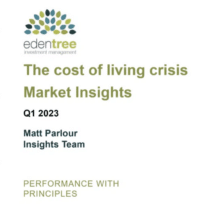Headlines in the last few weeks have been very worrying for investors. After a bad start to the year, the new Chancellor’s ‘mini-budget’ didn’t have the desired effect and has subsequently brought the topic of financial instability back into the news. But despite, or perhaps because of, the weakness in markets, there are now some great opportunities available to investors across asset classes, says Peter Stewart, strategic account manager, Waverton Investment Management.
At Waverton, we are watching the economic and financial developments carefully and, as active investors who are predominantly directly invested in the underlying assets, we are well positioned to adjust our holdings as and when we see fit. We have a fundamental understanding of the risks that we have chosen to take with our investments and feel that we are well placed for the coming months and years. We have a tried and tested investment process which we have confidence in.
It is important to note that as global investors we are not overly exposed to any one regional risk, we are far less invested in the UK than many of our peers for example, and while currency moves introduce a degree of uncertainty in international investments, the falling value of sterling has actually increased the value of some of our foreign assets. We are also able to hedge currency risk if we wish, something that we have recently done in some of our funds – locking in some of the returns that we earned from the move in the value of the pound.
We are, as always, wary of any macroeconomic risks that may exist, but are not yet convinced that a recession is inevitable, at least in the US where there is still a degree of economic momentum, and, for now, conversations between Waverton’s analysts and the management teams of various companies suggests that there is a degree of resilience to corporate profits.
Valuation is one (very important) aspect of our equity investment process, and the fall in equity markets this year means that we are still able to find companies that we believe are both attractively valued and fulfil our other selection criteria. One example is Netflix, which we previously avoided due to elevated content costs as it built its own library, significant competition from legacy media companies, and a premium valuation. Now, the price has fallen to a level which mitigates these risks and creates potential upside from a transition to an advertising supported subscription service. Given this, we believe it to be a good addition to some of our portfolios.
Within the Sterling Bond Fund, the historic fall in prices has meant that our Fixed Income team are now more bullish on bonds than they have been in a decade. At one end of the scale there are some great yields available on short-dated bonds, such as a Thames Water bond, that matures in seven months and offers an annualised yield-to-maturity of 6%. We are however being very selective with any credit that we buy. Government bonds are now offering better yields than they have for years – you can now earn 5% nominal yield, or 2% real – and are still likely to offer protection to a portfolio if there is a major shock to equity markets, particularly the longer-dated bonds.
A textbook 60:40 portfolio has had its worst start to a year since World War Two, as both equity and bond markets have suffered. This has served to highlight the importance of diversification within a portfolio. Waverton’s two alternatives’ funds – the Real Assets Fund and the Absolute Return Fund – have provided this diversification and, in aggregate, have out-performed traditional asset classes this year.
Frustratingly, some sub-sectors of these strategies have also seen very poor performance so far this year, but in the wake of these revaluations there are some potentially great opportunities – the UK REIT market now trades close to its all-time discount to NAV and in all prior periods when discounts have been over 20% to NAV forward looking returns on a one, two and three year basis have been sharply higher.
Not only do alternative assets provide diversification within a portfolio, but some are well positioned to perform in the current environment of higher inflation and rising interest rates. Many have inflation-linked incomes while some, such as commodities, look to hold their value in real terms and benefit from changes in demand from infrastructure and technology. There are also sophisticated products that we are able to invest in that actively benefit from the rising rates.
We believe that our active, global, diversified and direct style of investment means that we are well positioned, and that even if we do see a material economic slowdown, we maintain good exposure to downside protection vehicles that will help to preserve capital for our clients.




































